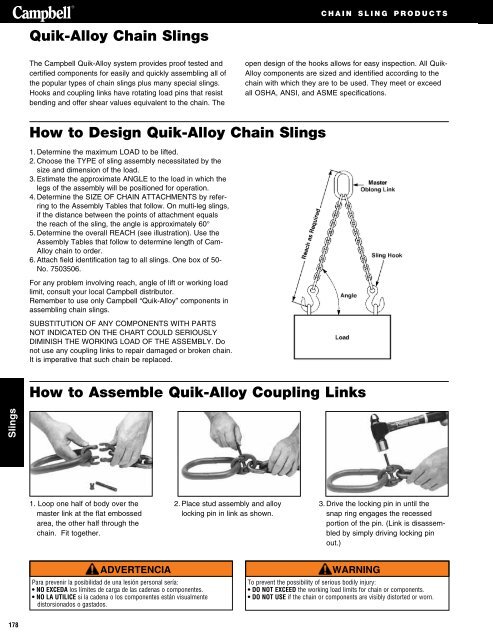Apex - Campbell
Create successful ePaper yourself
Turn your PDF publications into a flip-book with our unique Google optimized e-Paper software.
c h a i n s l i n g p r o d u c t s<br />
Quik-Alloy Chain Slings<br />
The <strong>Campbell</strong> Quik-Alloy system provides proof tested and<br />
certified components for easily and quickly assembling all of<br />
the popular types of chain slings plus many special slings.<br />
Hooks and coupling links have rotating load pins that resist<br />
bending and offer shear values equivalent to the chain. The<br />
open design of the hooks allows for easy inspection. All Quik-<br />
Alloy components are sized and identified according to the<br />
chain with which they are to be used. They meet or exceed<br />
all OSHA, ANSI, and ASME specifications.<br />
How to Design Quik-Alloy Chain Slings<br />
1. Determine the maximum LOAD to be lifted.<br />
2. Choose the TYPE of sling assembly necessitated by the<br />
size and dimension of the load.<br />
3. Estimate the approximate ANGLE to the load in which the<br />
legs of the assembly will be positioned for operation.<br />
4. Determine the SIZE OF CHAIN ATTACHMENTS by referring<br />
to the Assembly Tables that follow. On multi-leg slings,<br />
if the distance between the points of attachment equals<br />
the reach of the sling, the angle is approximately 60°<br />
5. Determine the overall REACH (see illustration). Use the<br />
Assembly Tables that follow to determine length of Cam-<br />
Alloy chain to order.<br />
6. Attach field identification tag to all slings. One box of 50-<br />
No. 7503506.<br />
For any problem involving reach, angle of lift or working load<br />
limit, consult your local <strong>Campbell</strong> distributor.<br />
Remember to use only <strong>Campbell</strong> “Quik-Alloy” components in<br />
assembling chain slings.<br />
SUBSTITUTION OF ANY COMPONENTS WITH PARTS<br />
NOT INDICATED ON THE CHART COULD SERIOUSLY<br />
DIMINISH THE WORKING LOAD OF THE ASSEMBLY. Do<br />
not use any coupling links to repair damaged or broken chain.<br />
It is imperative that such chain be replaced.<br />
How to Assemble Quik-Alloy Coupling Links<br />
Slings<br />
1. Loop one half of body over the<br />
master link at the flat embossed<br />
area, the other half through the<br />
chain. Fit together.<br />
2. Place stud assembly and alloy<br />
locking pin in link as shown.<br />
3. Drive the locking pin in until the<br />
snap ring engages the recessed<br />
portion of the pin. (Link is disassembled<br />
by simply driving locking pin<br />
out.)<br />
ADVERTENCIA<br />
Para prevenir la posibilidad de una lesión personal sería:<br />
• NO EXCEDA los límites de carga de las cadenas o componentes.<br />
• NO LA UTILICE si la cadena o los componentes están visualmente<br />
distorsionados o gastados.<br />
WARNING<br />
To prevent the possibility of serious bodily injury:<br />
• DO NOT EXCEED the working load limits for chain or components.<br />
• DO NOT USE if the chain or components are visibly distorted or worn.<br />
178

















